A manifesto for designs that do not know what bodies aren’t
“What can a body do?” is the question Spinoza puts to his readers in the third part of Ethics. For Spinoza, bodies are constituted not by predefined classifications but by encounters with material, social, and spatial forces. That means the body cannot be abstracted into neat categories of description, but exists in relation to broader contexts of power and meaning. Bodies are realized both through individual actions and by being acted upon, but the conditions under which a body can (and can’t) act are nearly limitless. Therefore, contained within Spinoza’s question is the radical idea that we not only don’t know what a body can do, but that we don’t even know what a body is. That Spinoza included this challenging question in his Ethics means that the forces that constitute bodies in a society’s space and time stem from decisions that carry ethical weight. These decisions are what we call “design."
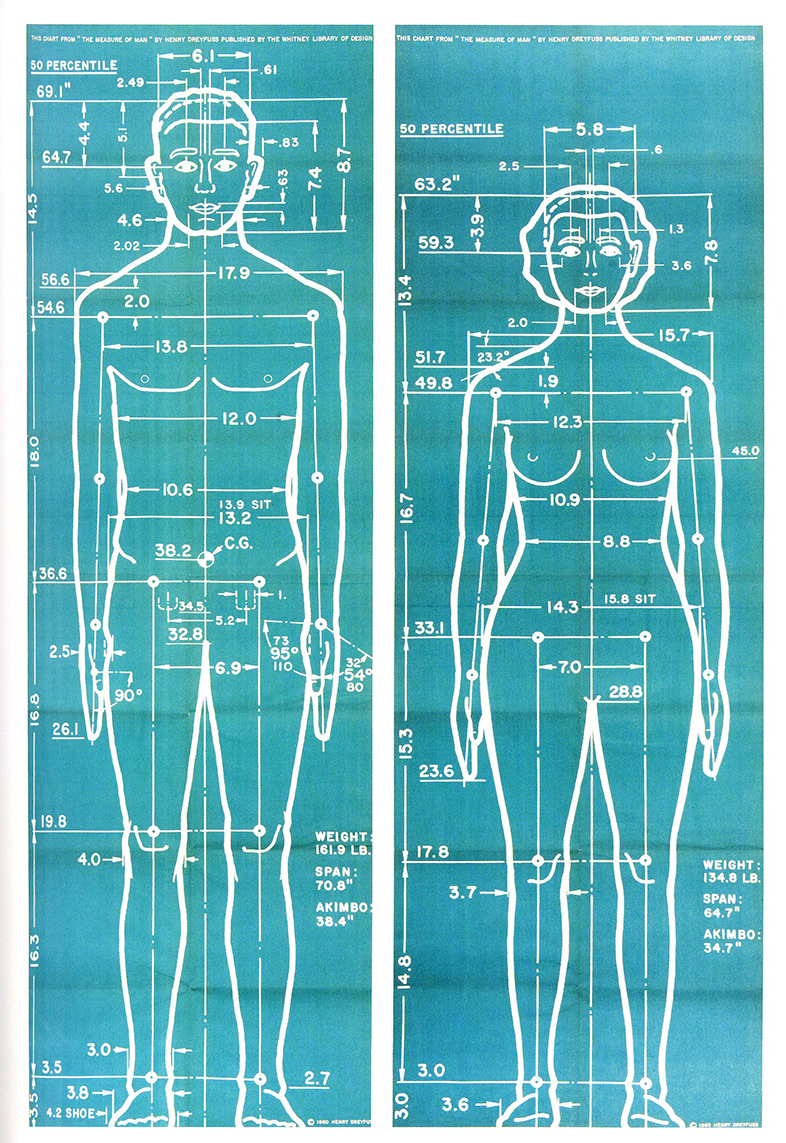
In the middle of the twentieth century, US industrial designer Henry Dreyfuss was also thinking about the ways in which bodies are situated in social contexts. His 1955 book Designing for People introduced a groundbreaking approach to industrial design that continues to shape and define the field of ergonomics and industrial design today. In his book, he uses two anthropometric models named Joe and Josephine—considered by some to be “the heroes of modern, functionalist design”—in order to emphasize “the human factor” of industrial design. We suggest that Joe and Josephine exemplify the socio-ethical problems of knowing too well what a body is. For Dreyfuss and the legacy of design knowledge he left behind, archetypal human bodies are white-skinned, able-bodied, of mythically average height and weight. They also fall neatly into the (hetero)normative two-gender binary system.
Dreyfuss designed objects and spaces not only to fit Joe and Josephine’s highly gendered bodies; Joe and Josephine gender the objects and spaces they inhabited. When chairs made for an airplane, an armored tank or a tractor are designed to correspond to Joe’s virtual and normative body dimensions, and when an ironing table, a telephone switchboard, or a vacuum cleaner are designed to correspond to Josephine’s body height and size, the abstract concepts of masculine and feminine bodies structure and define these objects, their uses, and the spaces they occupy. Although Dreyfuss’ standard bodies are easy to critique because of their explicit definition, most designers of the modern era operate with similar bodies in mind. Many still refer directly to Dreyfuss’ anthropometric data and models.
This is the social and ethical function of design standardization: to assign and put bodies in their “proper” place. Standardized design creates violent relations between bodies and environments. The intensity of violence the standard body brings to bear on an individual’s body is measured in that body’s difference and distance from the standard. A chair that is too high, a beam too low, a corridor too narrow acts on the body forcefully and with a force that is unevenly distributed. Bodies that are farther from the standard body bear the weight of these forces more heavily than those that are closer to the arbitrary standard. But to resolve this design problem does not mean that we need a more-inclusive approach to design. The very idea of inclusion, of opening up and expanding the conceptual parameters of human bodies, depends for its logic and operation on the existence of parameters in the first place. In other words, a more inclusive approach to design remains fundamentally exclusive in its logic.
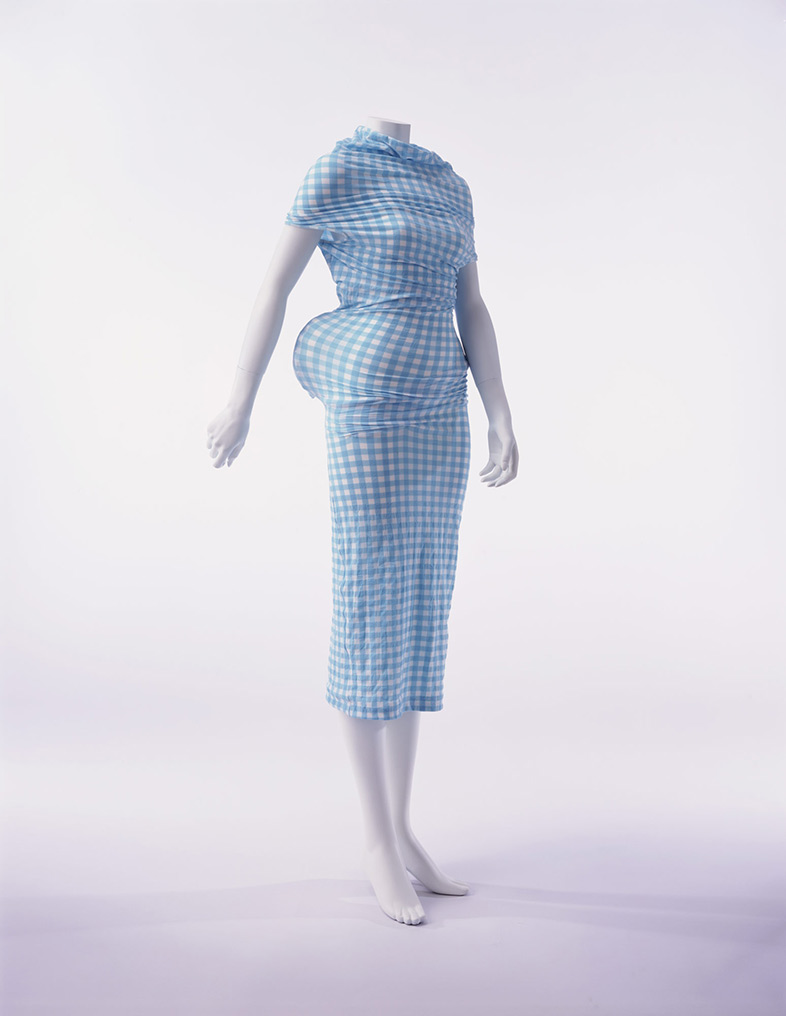
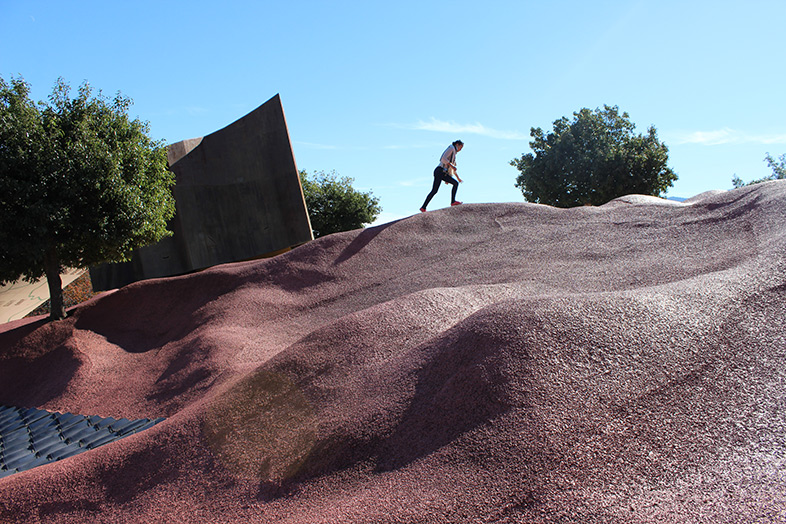
If Spinoza’s critical question points us toward an understanding of what standardized design does wrong, it also indicates how to get it right. The works of fashion designer Rei Kawakubo and of the artists-architects Shusaku Arakawa and Madeline Gins are the result of materialist practices that reflect the Spinozist principle of not knowing what a body is. Their approach to design is based not so much on what the designers claim to know about the body, but instead on what they ignore. Their approaches refuse predetermined conceptualizations of what a body is and what a body can do. For instance, Kawakubo’s “bumpy” dresses (from the highly celebrated “Body Meets Dress, Dress Meets Body” Comme Des Garcons Spring/Summer 1997 collection) form a cloth+body assemblage that challenges preconceived ideas of the body and of beauty. At a larger scale, Arakawa and Gins’ Mitaka Lofts in Tokyo and Yoro Park in Gifu prefecture deny any predetermined category of the body in favor of a profound ignorance of what makes a body a body at all.
These designs can have profound sociopolitical effects. Momoyo Homma (the director of the architects’ Tokyo office) relates how her mother, who normally cannot walk without her cane, had no problems navigating the bumpy floor of the Mitaka Lofts. Homma’s mother’s experience does not mean that the Mitaka Lofts are a miraculous instrument that would resuscitate a septuagenarian’s ability to walk without a cane. It reveals that her body only needs a cane in environments designed for bodies that differ substantially from hers.
The cane, itself a designed object, is a clear marker of the differential (often antagonistic) relations that design produces between bodies and spaces/places, and between non-standard and standard bodies. As a prosthesis, the cane’s purpose is to “correct” the non-standard body so that its functions reflect as closely as possible a fidelity with the “normal” body. Arakawa and Gins’ architecture offers an environment where the non-standard body does not need a “corrective,” since the environment’s design is not structured around what they think a body is.
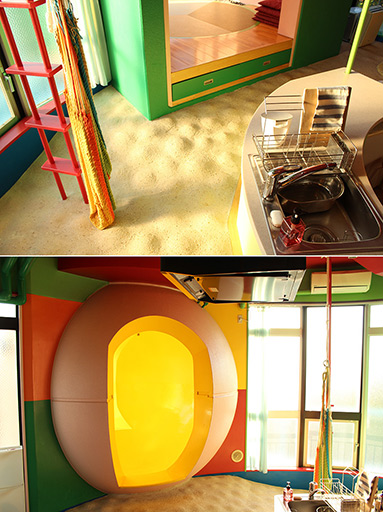
Spinoza’s question—what can a body do?—insists that we set aside preconceived and normative notions of what a body is. Arakawa and Gins’ architecture suggests a slight but significant revision: Rather than conceptualizing bodies from the position of not knowing what they are, we should begin from the position that we don’t know what bodies are not. The double-negative allows a crucial correction to the Spinozist account of the body.
Spinoza’s question delays conceptualizations of the body, but it still doesn’t do away with normative formulations of the body. Affirming an ignorance of something presupposes that what is ignored could be actually known. “We don’t know what a body is” implicitly suggests that a holistic knowledge of what a body is actually exists—we just don’t presume to know it (yet).
The position of “not presuming” is too close to the liberal stance of having tolerance for difference—a position of liberal multiculturalism we find suspicious. The problem with liberal tolerance is that it already assumes and takes up a position of power. The designer is in the privileged position of being tolerant of another, and of designating who is deserving of tolerance. Whether the presumption is to know or not know the body, it is either way an act of the designer’s agency since knowing/unknowing the body is realized exclusively in the design of the garment, room, chair, table, etc. The power of the designer remains intact either way.
Alternatively, to not know what a body isn’t does more than suspend or delay normalizing conceptualizations of the body. It refuses such total claims of body knowledge at all. Just as the double-negative construction becomes affirmative, not knowing what a body isn’t affirms all bodies by doing away with the ideal of the normative body altogether. To not know what a body isn’t means that the idea of the body is infinitely open, rather than just momentarily open. To not know what a body isn't means that all bodies are equally valid modes and forms of embodiment. Nothing is "not a body" and so everything is a body. This is not a philosophical issue but a political problem. What is a body? What is a human body? These are philosophical treatises that do not address our concern with how built environments empower some bodies and disempower others according to a set of “universal” design presumptions and methods.
By shifting our focus from what a body is to what a body can do, we can begin to explore the political—sometimes violent—relations of bodies, objects, and environments that are produced and maintained through standard design practices and knowledge. How might a collaborative relation of body and environment create the potential for a more non-hierarchical architecture? How might it build one that frees all bodies from the abstract concept of a “normal” body?
As impressive and seductive as the designers named above are, they are not politically egalitarian even though their designs may be aesthetically radical. Kawakubo, Gins, and Arakawa’s built environments are among a highly rarified class of design, out of reach to all but a select few inhabitants/consumers. Although their design approaches are unconventional, they don’t disrupt the hierarchical relations that structure dominant paradigms of design. In fact, their work is greatly celebrated in establishment fashion and architecture design circles.
A design process and philosophy that doesn’t know what a body isn’t can be found in a decidedly more mundane built environment. The jersey knit cotton T-shirt—a product found across the entire price point spectrum—is accessible and inhabitable by a great number of people. Jersey knit cotton is one of the cheaper fabrics, pliable to a broad range of bodies. Jersey knit cotton T-shirts really don't know what a body isn't—to this T-shirt, all bodies are T-shirt-able, all bodies can inhabit the space of a T-shirt, though how they inhabit it will be largely determined by the individual body. How the t-shirt pulls or hangs loose (and by how much) will certainly vary across bodies and across time. Indeed, the T-shirt’s stretchy jersey knit cotton materializes precisely this principle of contingency.
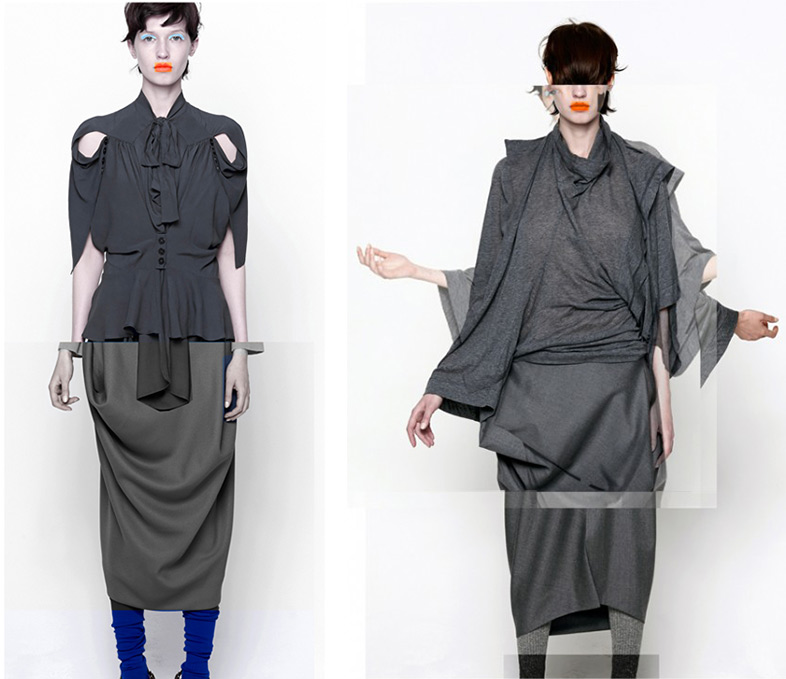
Julie Wilkins’ designs are aimed at “extending the grammar of the T-shirt.” Stretching the T-shirt to new proportions, her Future Classics Dress collections (made entirely of jersey knit fabrics, though not necessarily knit from cotton) are even more adaptable and modifiable than the classic T-shirt, which is somewhat limited by its fundamental T shape. (“Somewhat limited,” because its T shape has not precluded the vast number and variety of bodies that do not conform to the T-shape from wearing T-shirts.) Wilkins’ design approach is unlike those that make up traditional tables, chairs, windows, and clothing that are designed and fabricated around standard body dimensions. Wilkins’ designs create built environments that are pliant, dynamic, modular, and mobile.
Wilkins’ Future Classics Dress designs are modifiable by and adaptable to an unspecified range of bodies; they are conditional architectures. As demonstrated on their website, one garment can be worn in many ways, on many bodies. How users inhabit the clothes depends on them as much as on the designer. Choosing how to wear a Future Classics garment can be an involved process. While the Future Classics Dress collections don’t give individuals total autonomy, they allow bodies more freedom than we've seen before.
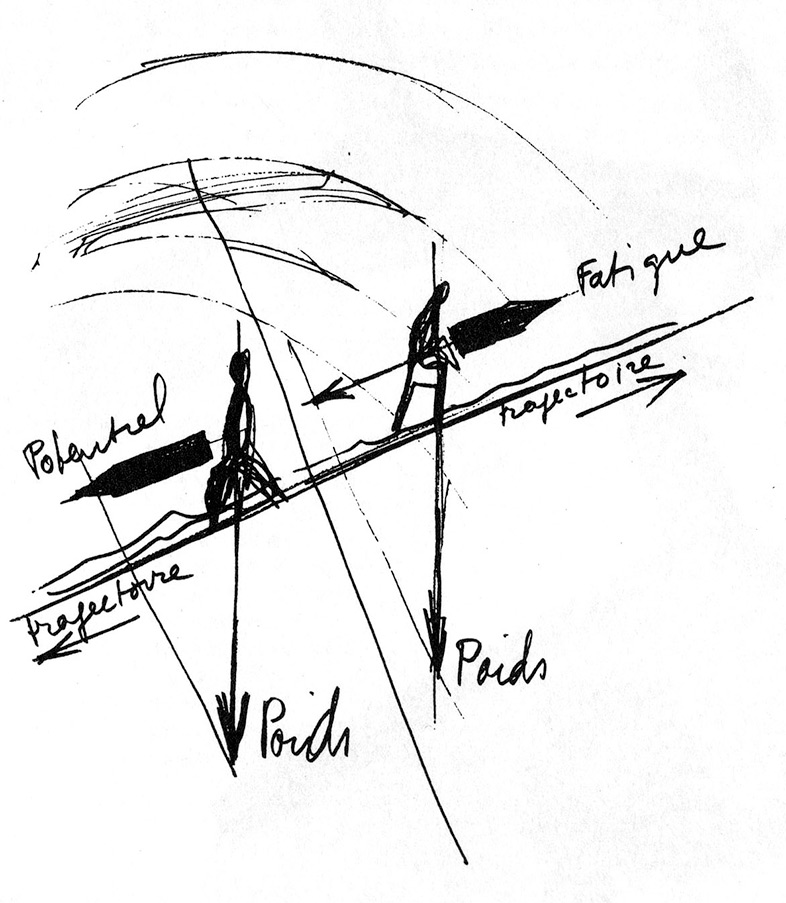
The architectural equivalent of the Future Classics Dress philosophy and forms can be found in the collaborative work of architect Claude Parent and cultural theorist Paul Virilio. Their architectural invention, named The Oblique Function, consists in tilting the ground to a degree that each body’s encounter with it is unique to the body’s specific and contingent relations to weight and gravity. The simplicity of Parent’s explanatory diagram is eloquent: The forces necessarily at work on each body (weight, potential, fatigue) vary depending on the trajectory of its movement. Parent and Virilio realized their invention in both speculative and pragmatic ways. They created drawings of entire cities with no flat floors, and successfully designed and built several buildings incorporating various types and combinations of oblique surfaces.
The Oblique Function also does not know what a body isn’t. Standard chairs and beds are overwhelmingly placed on and designed for flat surfaces. These assumptions impose predetermined interactions with bodies. Inscribed into the design and application of standard chairs and beds are ideal relations and positions between bodies and design. The Oblique Function’s re-interpretation of the built environment multiplies such positions without presupposing an appropriate relation before the encounter. The Oblique Function enables bodies to encounter surfaces in ways that are not determined by, and are in fact disruptive of, standardized body knowledge and design systems.
What the Future Classics Dress and the Oblique Function share is the significance of surface designs that celebrate bodily ignorance. These designs thrive by not knowing what a body is not. Here, “surface” means both the surfaces of bodies and their environments. We know from Spinoza that the relations of surfaces and bodies are measured and maintained by differing degrees of intensity. It is not only that bodies encounter surfaces with an inverse force (what we commonly call “ground” or “floor”) as a consequence of gravity, or that bodies’ relations with surfaces are mediated by a balancing of various weights with the weight of their own bodies (e.g., clothes or “wearable objects”). These encounters, and the intensity of their relations, have been largely fixed and naturalized. Design should denaturalize the standard body.
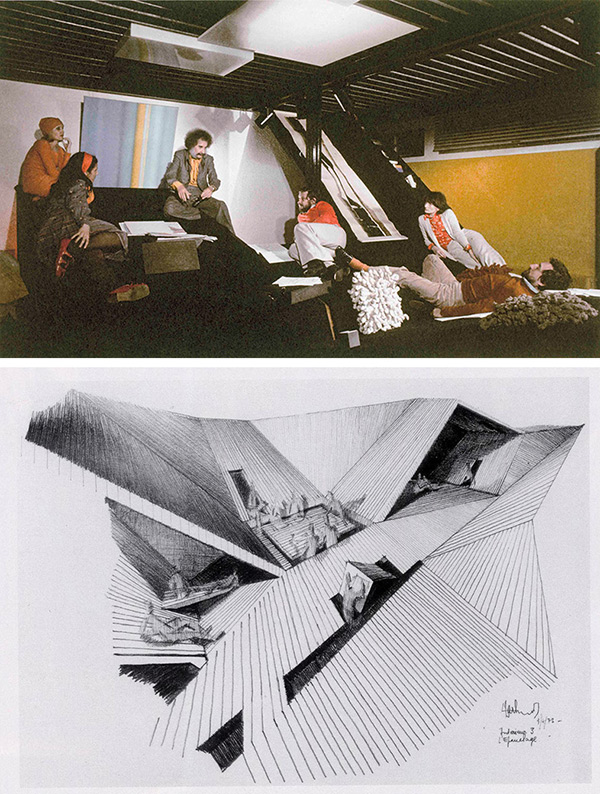
The idealized relationship of bodies and designed grounds is a predictive geometric one. It is widely accepted that a surface directly perpendicular to the body provides the best environment for bodies to function. As a result, the surfaces of designed grounds are overwhelmingly flat, and non-flat floors are marked as problems to be fixed. Yet even a cursory glance at any playground and its many and differently uneven grounds—“terrains” is a better word—trouble this taken-for-granted logic.
Children tend to have a particularly acute relation to their physical environment. Their small and unpracticed bodies almost never fit the overwhelmingly hard, flat surfaces of mainstream environments. In this way, all young children can be understood as having non-standard bodies. Their “unfitness” is measured in relation to normatively designed built environments. The image of any young child climbing a set of stairs illustrates the kind of unfitness we mean. By contrast, the playground’s dense rubbery foam floors, its flexible pathways (e.g, chain-linked bridges), and its integration of Parent and Virilio’s Oblique Function of various slopes and elevations, are surfaces that children’s bodies navigate capably, oftentimes with a level of ease that escapes adults.
Floors and clothing are exemplary everyday built environments, so pervasive that we tend not to notice them. They structure our every intimate, mundane, and extraordinary encounters with our own and others’ bodies and environments. The heterogeneous terrains evoked by Parent and Virilio’s theory of the Oblique Function and commonly found in playgrounds and the stretchy knit surfaces of cotton jersey represent models for a more non-hierarchical design and design philosophy.
What’s more, the intense encounters they enable and enact cannot be fully pre-known or pre-determined. How a particular body inhabits these built environments shapes and, crucially, activates the encounter. In Spinoza’s sense of the term, such terrain—because it invites activity rather than passivity—increases the potential for “joyful encounters.” But affective encounters exceed what Spinoza thought -- they aren’t limited to the poles of “joyful” and “sad” encounters. Designs that don’t know what a body isn’t provide for more stretch and give. By putting Spinoza in a jersey knit cotton T-shirt, we can critically imagine designs where the body and its environments exist in a different relation, one that stands outside of the violence that both of them meet in now.
